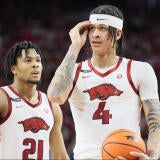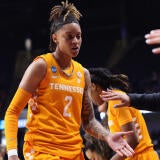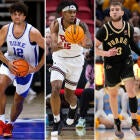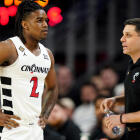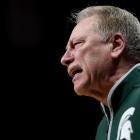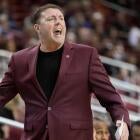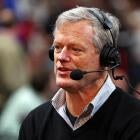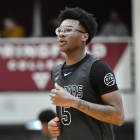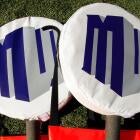The Top 25 (And 1) biggest stories in men's college basketball since 2000
The players, coaches, games, moments and off-the-court stories that had the greatest impact in college hoops in the past 25 years
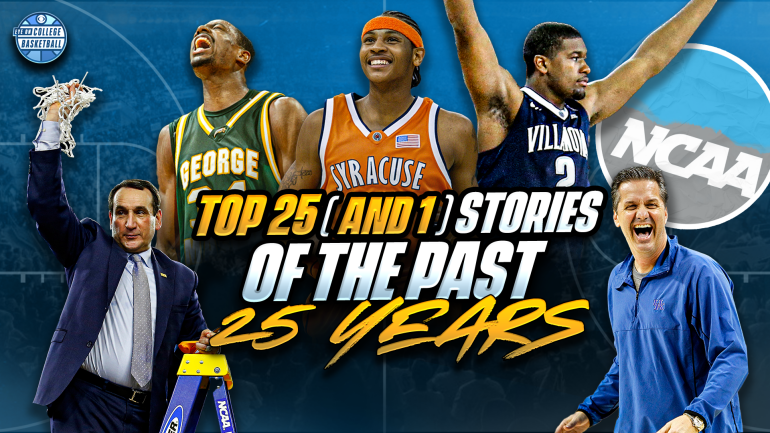
Over the past 25 years, dozens of stories and moments have significantly added to the lore of men's college basketball. In that span, the sport has witnessed some of its greatest coaches win championships and, inevitably, end their careers. It's seen some teenagers enter into its arenas and leave college as bona fide legends.
Beyond the individual figures, the contours and definitions of what constitutes what college basketball is has drastically changed from what we knew it to be 25 years ago. The NBA-initiated one-and-done era was born in the past quarter-century. The NCAA Tournament expanded twice. The rules regarding transfers and how coaches are allowed to recruit have been rewritten a dozen times. Biggest of all, the amateurism model that existed for more than 100 years was finally undone.
There's been so much that has happened to this great game over the past two and a half decades.
And because I simply can't help myself, with this being the year 2025, I decided to whittle down the 25 — well, no, actually, I couldn't even do that. It's the Top 25 (And 1) biggest stories in the sport since 2000. Hop in the time machine with me as we scan back over the past 25 years in men's college hoop.
Plus, if you'd like to listen or watch Gary Parrish and I take the scenic route through this list, we recorded a five-episode series this summer on Eye on College Basketball. Here are the episodes on YouTube:
And 1. Early conference realignment earthquake. Miami, Virginia Tech bail on Big East for ACC (2004), Boston College follows (2005).
Realignment has always been a thing in college sports, with teams switching leagues for basically 100 years. One move begets another and another. Some decisions are much more significant than others. In 2004, Miami and Virginia Tech left the Big East for football reasons, and in doing so set in motion the major fissures that would come later in the 21st century.
A funny line from The New York Times on June 30, 2003: "The addition of Miami and Virginia Tech could transform the A.C.C., best known for its top basketball programs, into a football powerhouse."
We know how that turned out.
Back in the early 2000s, the Big East tried to sue to block the action and failed. Then-Big East commissioner Mike Tranghese was quoted at the time: "I think the public is disgusted with us all to be honest with you." The ironic twist: Boston College and Syracuse were the two schools that worked hardest to get Miami to stay. A year later, BC left for the ACC and Syracuse would eventually follow in the 2010s.
It's not like the Big East suffered in the 2000s. When BC left, the league mutilated Conference USA by poaching Cincinnati, DePaul, Louisville, Marquette and South Florida to form a 16-team conference, the largest in history.
On the ACC side, let's check in: Miami's never won a football conference title since joining, Virginia Tech has been erratic at best and BC might be the biggest loser of any power-conference team to switch leagues in the past two decades.
25. Villanova coach Jay Wright retires (April 20, 2022).
There have been a number of notable retirements since 2000, but the shock value and symbolism of Wright's outpaces all others. At 60 years old, coming off the fourth Final Four of his career and still operating in his prime at Villanova, Wright decided the grind was no longer for him. He saw the first season of NIL-affected college basketball and didn't want any more of it. (Tony Bennett would retire for similar reasons in October 2024.)
Wright won 642 games, two national championships, 13 combined Big East titles, was a two-time Naismith Coach of the Year and six-time Big East Coach of the Year. It all led to a Naismith Memorial Hall of Fame induction in 2021. Wright quickly pivoted to television work, where he's predictably been terrific and figures to grow into one of the game's most prominent voices on the media side.
24. NCAA gets dangerously close to expanding tournament to 96, receives massive pushback, grows from 65 to 68 (April 2010).
As of this story's publishing, the fate of the NCAA Tournament remains twisting in the wind. Any expansion is uncalled for, as it remains an unpopular concept for the sporting public, but 96 is on a level so cartoonish it prompts instant mockery.
And yet, we came dangerously close to having a 96-school tournament not so long ago.
This is how an AP story from April 1, 2010 read: "The NCAA appears to be on the verge of expanding the men's basketball tournament to 96 teams. Insisting that nothing has been decided, NCAA vice president Greg Shaheen nonetheless outlined a detailed plan Thursday that included the logistics and timing of a 96-team tournament, how much time off the players would have and even revenue distribution. Shaheen said the NCAA looked at keeping the current 65-team field and expanding to 68 or 80 teams, but decided the bigger bracket was the best fit logistically and financially."
Three weeks later, the NCAA wised up and merely decided to go to 68. In doing so, logic won out, the regular season was preserved and the tournament — though no longer perfect with a 64-team start — managed to hold on to a near-perfect shape and format. Hopefully, it stays that way into the 2030s. (Another part of this story: CBS and Turner also teamed up, and so in 2011, every single game of March Madness was viewable on TV for the first time.)
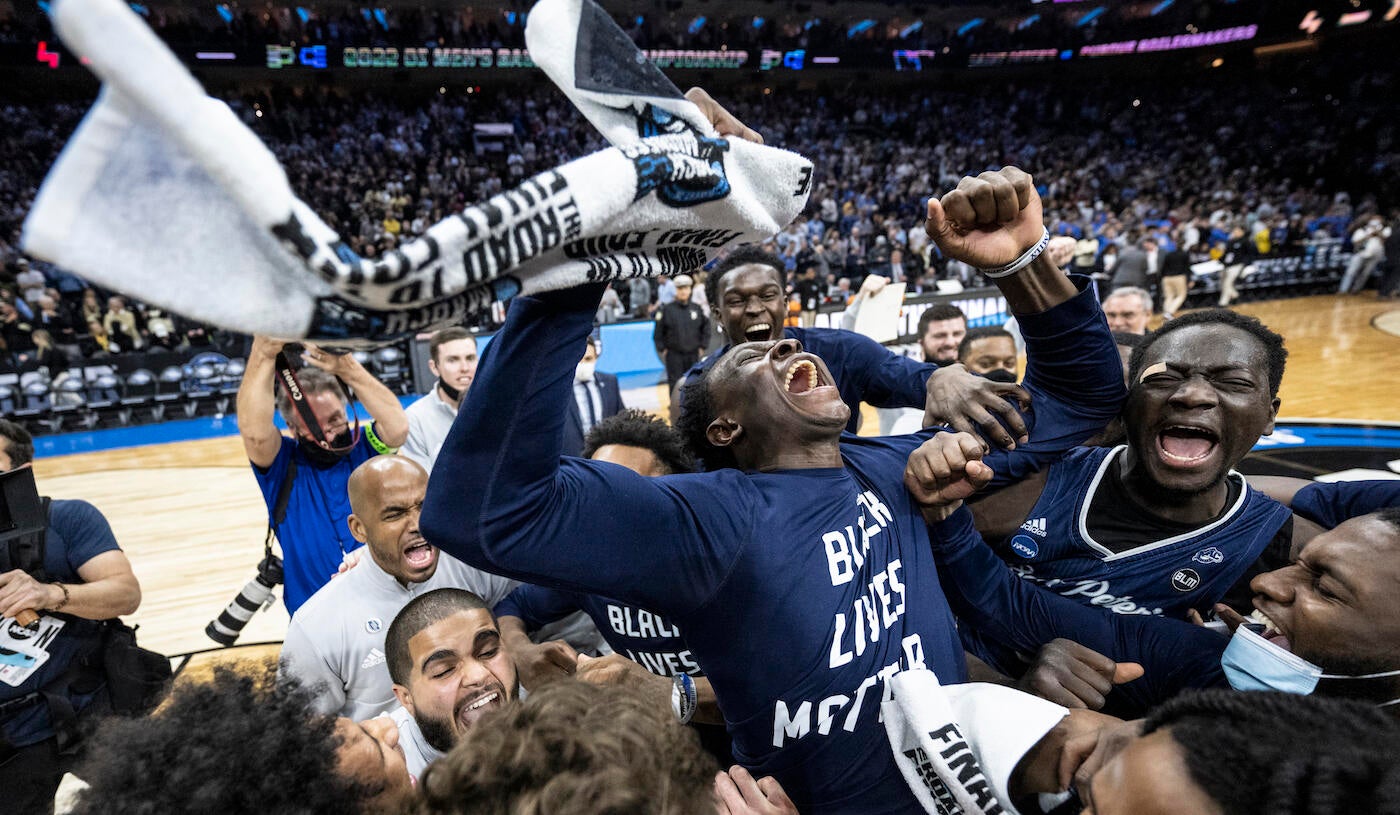
23. Saint Peter's becomes first No. 15 seed to make the Elite Eight (March 2022).
We'd seen No. 15 seeds win two games before. There was Oral Roberts in 2021 and Florida Gulf Coast in 2013. Even Princeton made the Sweet 16 in 2023. And teams like Norfolk State, Lehigh, Hampton, Coppin State and Richmond had tasted March Madness glory from the 15-line.
But the Peacocks were unprecedented.
The champs of the MAAC, coached by Shaheen Holloway, upset No. 2 seed Kentucky 85-79 in OT in the first round, beating the Wildcats with NPOY Oscar Tshiebwe. Then came a win over No. 7 Murray State to make the Sweet 16, followed by a definitive upset of No. 3 seed Purdue with Jaden Ivey, Trevion Williams and Zach Edey.
Doug Edert and company provided the most unlikely Elite Eight run in tournament history. It took almost 40 years (since the 64-team era began in 1985) for a 15 to make the Eight. It may take another 40 for us to see something like this again, but when it happens, the rarity of it all will make it that much more memorable.
22. Stephen Curry's legend begins with Davidson's Elite Eight run (March 2008).
Before the NBA championships, Olympic gold medals, MVP awards and icon status as the Greatest Shooter in Basketball History, a lanky kid who couldn't land a scholarship offer from Virginia Tech put Davidson on the map. Curry and the Wildcats were a No. 10 seed that started the 2007-08 season 4-6 with losses to UNC, Duke, UCLA and NC State. Then they won 22 in a row heading into the NCAAs.
Davidson was a trendy first-round pick to beat Gonzaga, which it did by six. That was the start of one of the most famous single-player-fueled NCAA Cinderella runs ever.
Curry totaled 128 points in four games, averaging 32 points in addition to making 23 3-pointers. Davidson knocked off No. 2 seed Georgetown in the second round, then booted 3-seed Wisconsin in the Sweet 16 — by 17 points.
Curry and the Wildcats came oh-so-close in the regional final, falling by two to Kansas. Davidson finished 29-7, finished 11th at KenPom and Curry rose to permanent national star status thanks to a four-game run that captured the country's attention. It was a huge deal then. In retrospect, it's become even bigger because of Curry's ascendance as a top-15 all-time player in NBA history.
21. UNC faces no punishment after infamous widespread academic fraud case (2010-17).
Here's how I described the end of one of the most anticipated NCAA rulings in history: "A seven-year saga, more than four of which included formal NCAA investigations, with three separate elongated stages, and untold amounts of dollars and billable legal hours put toward it, completes with no sanctions. No sanctions or probation or punishments for a school that had internal and independent reports verify hundreds of students — many of them athletes — benefitting from hundreds of phony courses dating back to 1997."
A story that went public with a probe into improper academic benefits to football players in 2010 led to exposure of phony classes in the African and Afro-American Studies department at UNC, looping in the basketball program and ... it led to nothing. UNC was handed three different notices of allegations and eventually charged with five Level I violations. But the school was never punished because, ultimately, it was determined that the University of North Carolina at Chapel Hill had a widespread academic fraud issue that wasn't solely aiding college players.
It was an institutional issue, not an athletics one.
It can be argued that a lack of punishment made the story even bigger and made the NCAA look even worse than usual — particularly because the verdict came six months after UNC won a national championship that year in men's basketball.
20. JJ Redick and Adam Morrison's season-long race for National Player of the Year (2005-06).
This storyline was covered back in February, when Cooper Flagg vs. Johni Broome prompted me to look back at the best NPOY races of the past 40 years. Here's what I wrote: "Given the raw scoring prowess of both players, this is considered the best modern NPOY race ever. Redick was recognized by all six major outlets, though he split the vote with Morrison for the Oscar Robertson POY and the NABC poll. Morrison's 28.1 points led the nation in scoring, with Redick second at 26.8. At 139 made 3-pointers, Redick led the nation in beyond-the-arc proficiency. Morrison's 240 made foul shots were tops in hoops.
Redick's Duke team finished No. 2 at KenPom. Gonzaga was a 29-4 WCC powerhouse that finished outside the top 30. Duke was a top seed, while GU was a No. 3. Both teams won their leagues, but both were knocked out in the Sweet 16 in surprising fashion. Duke was stomped by an ultra-athletic LSU team, while Gonzaga notoriously blew one of the biggest leads ever in NCAA tourney history, falling to UCLA. Morrison's career ended with him crying on the court in the closing seconds."
It was two scorers from opposite coasts with different games and different followings. Redick playing for the blue blood with rock star-type adoration and swagger (and that swagger also made him easy to hate for many). Morrison was a crunchy, mustachioed cult hero out of the Pacific Northwest, the player who brought Gonzaga to its next stage of legitimacy. He also had the top game that season when he scored 43 points in one of the best games of the past 25 years: Gonzaga's 109-106 win over Michigan State in triple OT at the Maui Invitational.
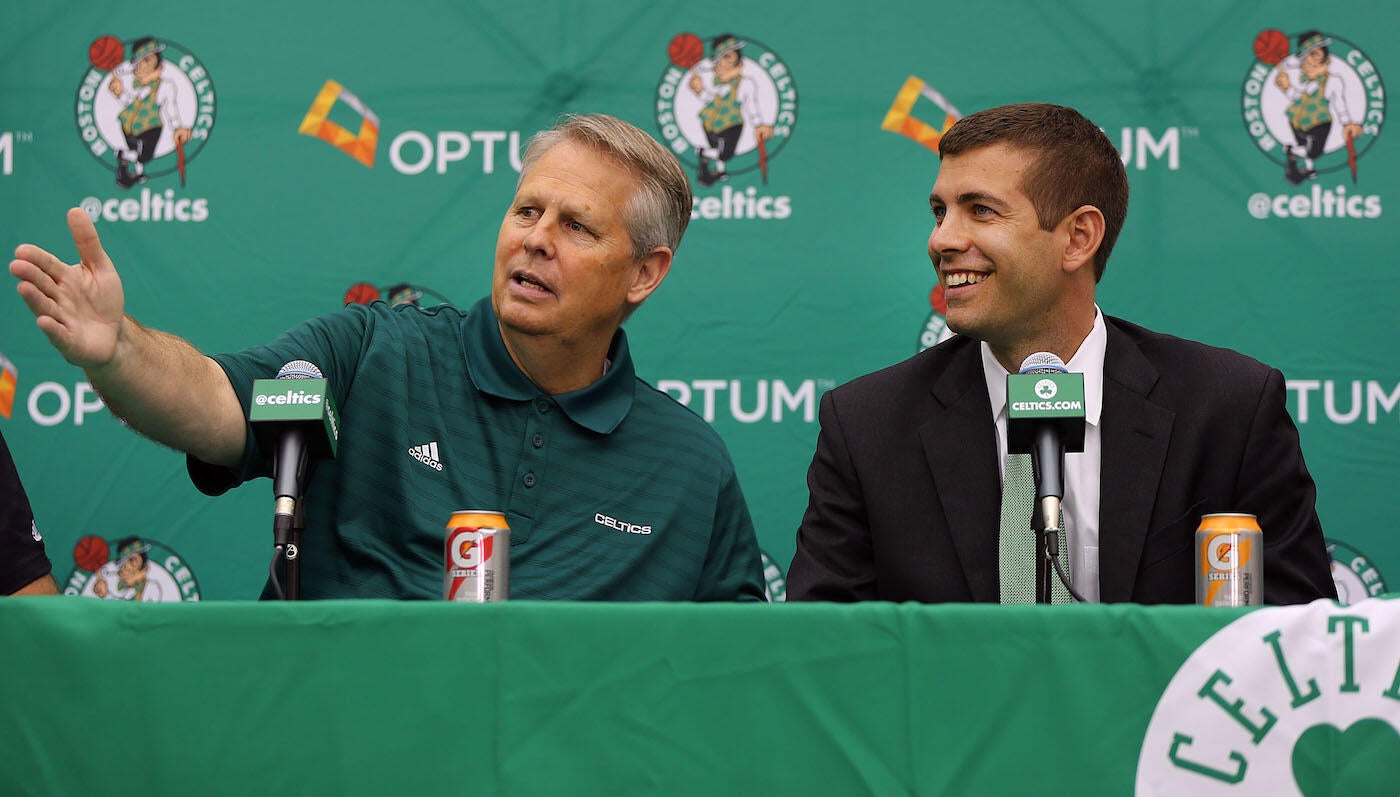
19. Brad Stevens leaves Butler for the Celtics (July 3, 2013).
A few of these stories make the list because of their shock value, and this one absolutely qualifies. On the day before the Fourth of July, just after 5:30 p.m. ET, Butler and the Boston Celtics jointly announced that 36-year-old Brad Stevens would be taking the Celtics job. It was in no way hinted at before that moment. A stunning news dump heading into a four-day holiday weekend.
Stevens had been attached to previous openings in college, but he never actually engaged in any discussions about leaving Butler. He went 166-49 with BU, including a 12-5 record in the NCAAs and two title game appearances (keep scrolling). His 166 wins is the most for any NCAA Division I basketball coach over the first six years to start a career.
In a testament to how coveted he was, Stevens' Butler contract in 2013, when he took the Boston job, lasted all the way until this year, 2025.
Because of Stevens, Butler went from Horizon League to A-10 to the Big East. He holds an distinct legacy in the college game.
College hoops was worse off for not having Stevens in it, as was Butler. But Stevens did OK for himself, winning way more often than not in eight seasons as an NBA coach, before stunning again by leaving coaching to run the Celtics' front office. He was rewarded there, winning NBA Executive of the Year in 2023-24, when the Celtics won the NBA title.
18. Loyola Chicago makes the Final Four, Sister Jean becomes a bona fide national sports celebrity (April 2018).
A cheery nonagenarian nun in a wheelchair was one of the 20 biggest stories of this century in college basketball — a glorious reflection of how sweet this sport can be.
This woman, Jean Dolores Schmidt, turns 106 in August! She has been with Loyola Chicago since 1991 and remains the chaplain for the basketball team. Her role in the Ramblers' resplendent run to San Antonio in 2018 was so adored, she became a sports icon. The Friday press conference was unlike anything I've ever covered: 50-plus TV outlets and more than 150 members of the news media all crammed into a room to hear a few words from the most in-demand nun since Mother Teresa.
Need three shots to span the room. pic.twitter.com/ay6wNsXcEC
— Matt Norlander (@MattNorlander) March 30, 2018
That Loyola squad went 32-6 under Porter Moser and earned a No. 11 seed as a 28-5 team out of the Missouri Valley. It won its first three NCAA tourney games by a total of four points: 64-62 over Miami, 63-62 over Tennessee and 69-68 over Nevada. Three players were responsible for the game-deciding baskets, a fitting sharing of the spotlight for a team that captured America's heart. Relive it here:
17. Almost Immortal: 38-1 Kentucky and 31-1 Gonzaga lose their only games in the final weekend (2015, 2021).
The temptation of an undefeated team in men's college basketball is such an alluring storyline whenever it makes it to March, but after seeing these two teams fail to run the table, it's fair to wonder if we'll ever see an unbeaten national champion ever again.
That Kentucky team had Karl-Anthony Towns, the Harrison twins, Willie Cauley-Stein, Trey Lyles, with Devin Booker and Tyler Ulis off the bench. In the lead-up to the NCAA Tournament, the one team that was considered a true threat to UK's unbeatable status was the team that indeed knocked them out: Wisconsin.
The 38-1 season had an effect on John Calipari's reputation in the all-time coaching conversation. Two NCAA titles is different than one. Ask Jay Wright, Dan Hurley, Bill Self, Rick Pitino — and the guys with one, like Tom Izzo and Jim Boeheim. It's a notch below. If Cal has a 40-0 season on his resume, it undeniably changes his legacy. Maybe it's so strong, he never even leaves Kentucky eventually? I don't know. But 38-1 came to signify something of an albatross, unfair as it may be.
As for Gonzaga, its 2020-21 greatness needs reinforcement, as that season was COVID-riddled, with a variety of cancellations. With a 32-game inventory, as opposed to 40, Gonzaga's run wasn't held as high, so here's your reminder. That team rates as one of the most efficient in modern history. The 2021 Zags are alongside the likes of 1991 UNLV, 1999 Duke and 2015 Kentucky as the best to not win a championship.
That title game loss to Baylor was the fifth in men's history, and first in 20 years, to spotlight the preseason Nos. 1 and 2. They had a combined two losses, the fewest in a championship game since 1966. Their combined .967 winning percentage is the highest in a title game ever.
GU easily finished No. 1 at KenPom despite being rolled 86-70. Prior to that, Jalen Suggs' 37-footer to win it at the buzzer in overtime against UCLA provided an all-time moment for an amazing team, but its dominance is overshadowed by losing so definitively to Baylor.
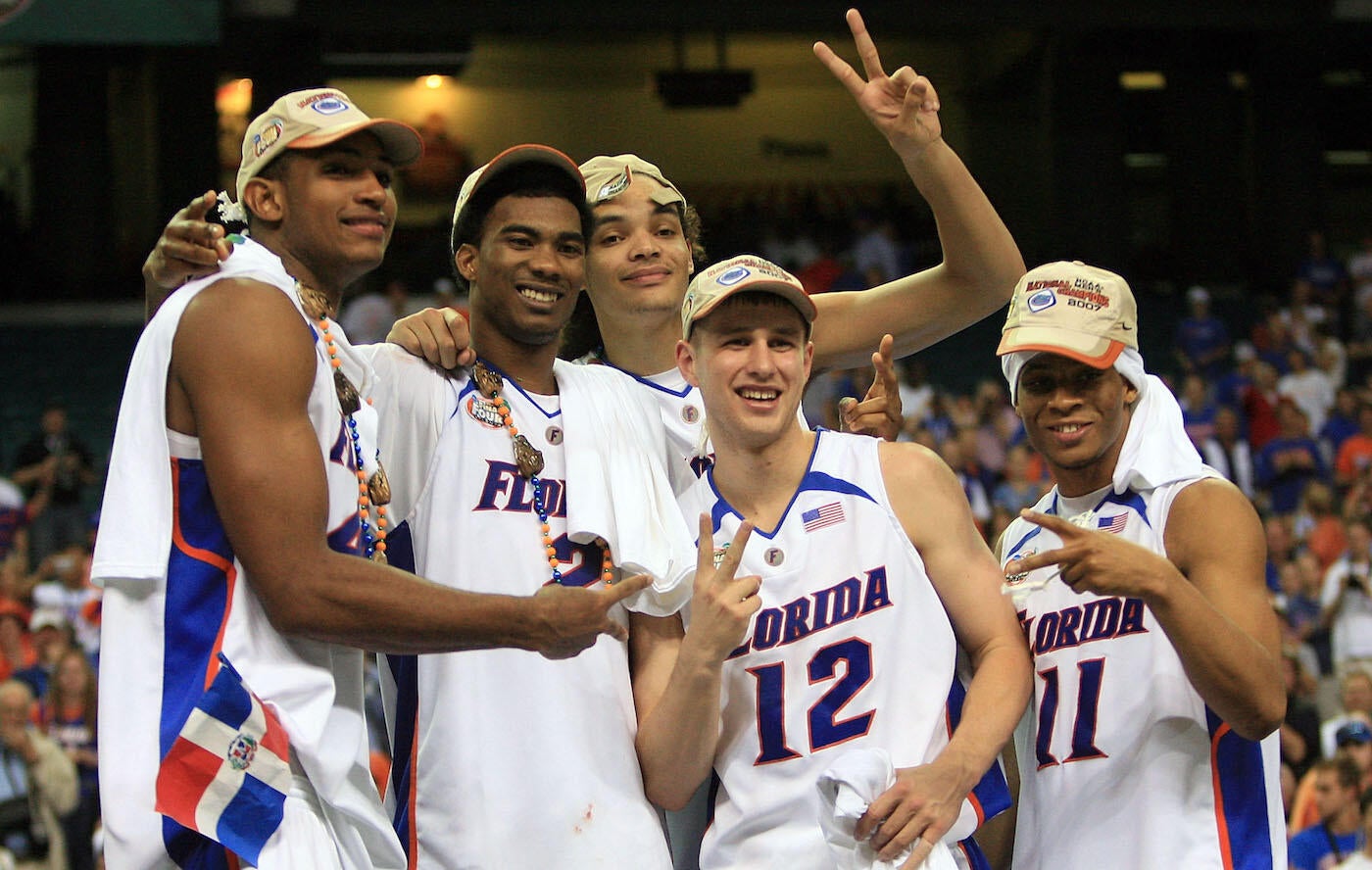
16. Florida becomes first team since Duke to win back-to-back titles (2006, 2007).
Something we'll never see again, so long as collective bargaining isn't allowable in college athletics. I'm talking about this specifically: Joakim Noah, Taurean Green, Al Horford and Corey Brewer all average between 11.3 and 14.2 points as sophomores. They win the national title. And this quartet, which entered college together, decides to return to try and win two in a row, bypassing surefire draft-pick status.
Then they did it.
We're not going to see that again.
In 2005-06, Florida went 33-6, had the third-best SEC record (10-6) and was handed a No. 3 seed. And yet, that Florida team is the only one to finish No. 1 at KenPom. It beat Georgetown (with Jeff Green and Roy Hibbert) in the Sweet 16 by four points, its only game in that tournament decided by single digits. UF knocked out 1-seed Villanova in the Elite Eight; that team was one of the five best Nova squads under Jay Wright. Florida won by 13.
They beat George Mason by 15 in the Final Four (keep scrolling), then trounced UCLA in the title game by 16.
A year later, Florida went 35-5 and strutted to the title game, where it knocked off Greg Oden, Mike Conley and the Ohio State Buckeyes. They set the standard in Gainesville, a standard matched this year, of course. But this year's team didn't have the storyline power of Noah and Co.
15. UConn dominantly goes back-to-back, ascends to blue blood status (2023, 2024).
Back-to-back listings for back-to-back championship winners. UConn edges out Florida for the record-setting nature of the Huskies' struts to their natties.
The Kemba Walker-led Huskies team that won it all in 2011 was in strong consideration for this list but wound up being one of the final cuts.
Truth be told, UConn's got a bigger story this century anyway.
In 2023, Dan Hurley's program went 31-8 and won the title as a No. 4 seed, but it never lost to nonconference competition that season and won its six tournament games by an average of 20 points. In the final four games of that tourney, UConn held all its opponents under 35% shooting, which had never been done. That group also trailed for a total of 55 seconds in the six second halves of that tournament.
Outlandish.
The 2023-24 team was even better.
That group went 37-3 and has a strong case as a top-three team this century. It beat opponents by 23.3 points in the NCAAs, never trailed in the second half and had a point differential of +140, the highest in NCAA history. It added up to two titles with 12 straight games of 13-plus point victories. It validated UConn, permanently, as a blue blood — giving the school its fifth and sixth championships in a 26-year span. It also vaulted Hurley to face-of-the-sport status, where his perch remains.
Certain programs winning titles under certain circumstances wind up carrying more narrative weight. UConn's destruction of the tournament two years in a row is a level of supremacy we may never see again.
14. John Calipari leaves Memphis for Kentucky (March 2009).
Calipari's departure from Kentucky to Arkansas in 2024 nearly made the list, and for as big of a story as that was, it didn't have the profound impact of Cal's Kentucky flip in '09. It was the first college hoops coaching change dominated by online coverage.
After the disastrous hire of Billy Gillispie flamed out two seasons in — a soon-to-be-fired Gillispie being chased in UK's facilities by TV reporter Alan Cutler also plays into this story — UK was desperate to land a coach who could have command of the job, handle the immense pressure of Camelot and bring Kentucky back to the forefront of college hoops.
Cal was the perfect candidate.
After nine seasons at Memphis with six NCAA bids, four trips to the Sweet 16 or better — including the '08 title game — he was the no-brainer top choice. The search online got so frenzied, a Memphis news station broadcasted an online live stream of a door at Memphis' facilities that was supposed to eventually show Cal walking out of the building. "The Door" spawned Facebook pages and became one of Twitter's first viral moments in sports.
It was also supposed to be the white-smoke signal that a change was coming in Kentucky's favor. Eventually, it did.
Calipari's hiring altered college basketball's recruiting dynamic for a generation. He brought on more NBA picks, five-stars and one-and-doners than any coach in history. He was the perfect coach at the perfect time. Memphis has never recovered. You can make the argument that if Cal hadn't left when he did, even if he waited two or three more years, Memphis could/would have been in a different conference.
13. Zion Williamson becomes the biggest star this century in college basketball (2018-19).
In March, I built the list on which players meant the most to the sport over the past 25 years, and it's true: Zion was the biggest deal and more famous while in college than anyone else.
Here's what I wrote: "A supernova. ... He played for Duke, had a superstar name, megawatt smile, unique blend of power and pop and was the focal point on a No. 1 seed. ... Doing it for 32-6, top-seeded Duke team in the social media era absolutely played a major factor in Zion's unique rise to the top of American sports culture. It's why I have him No. 1, in addition to his megawatt style of play with the Blue Devils. He was so great so fast, even missing five games in the regular season to injury didn't hold back his prominence.
The guy got Barack Obama courtside for one of his games. Zion's combination of power, athleticism, leaping ability and charisma made him the perfect player at the perfect time in college hoops. His presence was a reminder for college basketball, and sports fans, that this is what the sport can still do for players making their way to the NBA. By some metrics he was the most valuable single-season statistical player in the sport in the past 25 years. A supernova, and the biggest bona fide star, in the truest sense of the word, the sport has seen this century."
12. Carmelo Anthony becomes first one-and-done freshman to guide a team to an NCAA title (April 7, 2003).
That Syracuse team holds a special place in college basketball history. Anthony was highly hyped heading into that season and delivered on expectations in a way that had never been witnessed. Like Zion, Carmelo was also one of the biggest stars of this century, and I wrote this about him in March: "It wasn't just that Anthony was a star for a school that has broadcast media alumni across the sports landscape (though that doesn't hurt), he also had a signature look: cornrows under an orange headband and a not-too-tight, not-too-baggy Cuse get-up. He was a Vibe. Hakim Warrick's block vs. Kansas clinched Syracuse's only national title, but Anthony (who wasn't even a First Team All-American that season, exposing a flaw in regular-season award voting) became the face of Syracuse greatness."
He got Jim Boeheim his only national title and elevated Syracuse's brand from a program that was Almost Good Enough for two decades to a program that could win it all. I maintain his one year at Syracuse defines him more than any other part of his basketball legacy.
11. Kris Jenkins wins it at the buzzer for Villanova over UNC in the national title game (April 4, 2016).
Huge moments and huge stories aren't the same thing, but sometimes a moment is so big it becomes a story unto itself. Jenkins hitting that shot in Houston is one of the three biggest moments in college hoops this century, and thus elevates to one of the biggest stories. His name is forever. That shot will play until the sun swallows the earth. It was a privilege to be in the building to witness the greatest ending in college basketball history.
Ryan Arcidiacono took six dribbles, tossed it off to Jenkins, who was ready and unleashed a parabola that provided one of the more memorable moments in American sports of the past 25 years.
The winning play was aptly named "Nova."
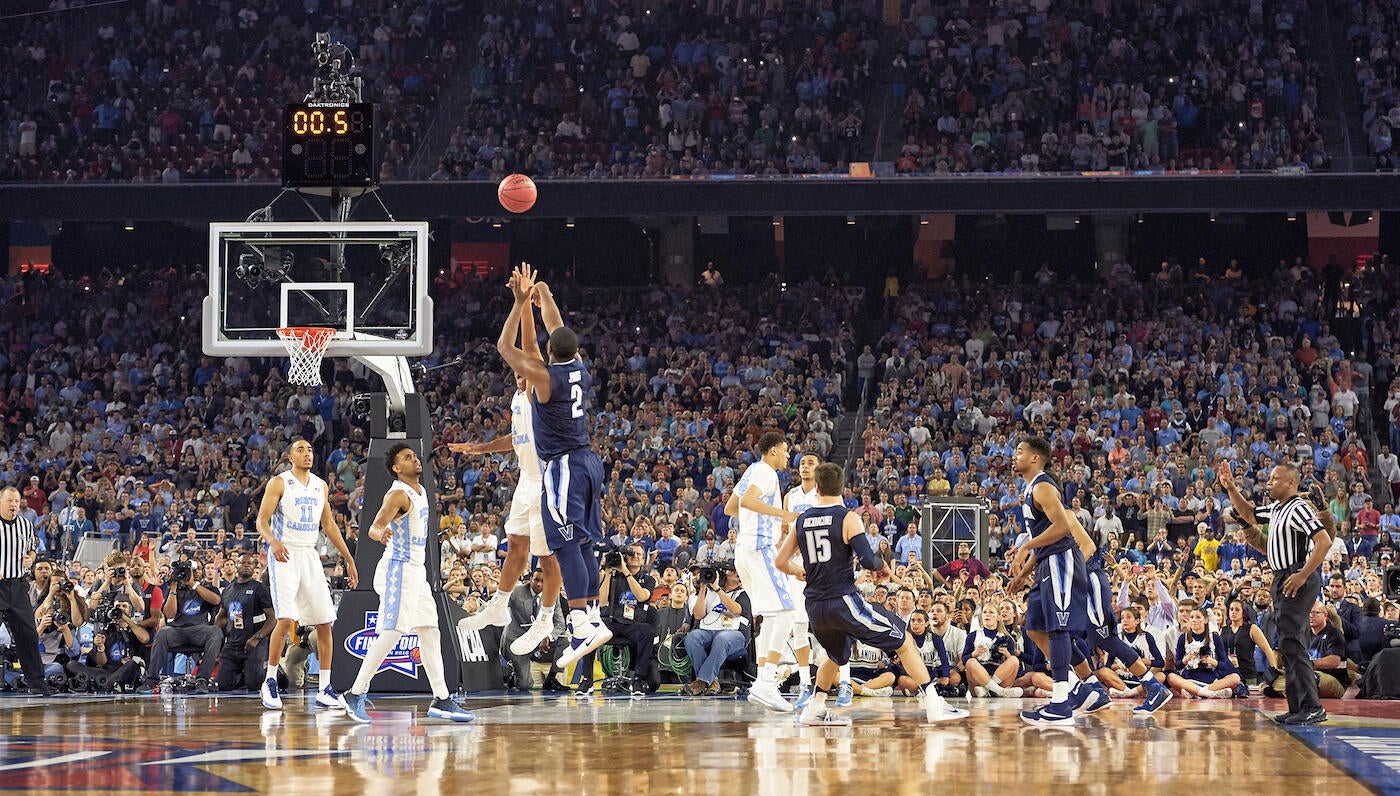
It was the first true buzzer-beating shot ever in a championship game (Dereck Whittenberg's airball falling into Lorenzo Charles' hands technically doesn't qualify). The buzzer-beater was huge for Villanova and for the Big East in the league's reconstruction after conference realignment.
To make the ending even better, Marcus Paige's circus 3-pointer the play before is on the short list of most incredible plays in a losing effort in college sports history. But also: the play produced one of the coldest reactions ever to a game-winning result.
Never forget Jay Wright's reaction to winning the 2016 NCAA Championship. pic.twitter.com/nNc5q3jbHr
— CBS Sports (@CBSSports) April 20, 2022
10. Huge conference realignment leads to Catholic 7, near death and ultimate restructuring of Big East (2010-13).
It's when college football redrew the map of college basketball forever.
First: Over a 48-hour span in the summer of 2010, Colorado left the Big 12 for the Pac-10 and Nebraska left the Big 12 for the Big Ten. Those were the dominoes that set into action movement that redefined the assembly of college sports than a decade later.
At one point, the Pac-12 tried to convince Texas, Texas Tech, Oklahoma and Oklahoma State to leave the Big 12, and it would have happened if not for Texas saying no. In the process, the Big 12 nearly died. (The irony: The Pac-12 would fall victim to near-dissolution more than a decade later when the Big Ten took its four most important schools.)
The shuffling included Utah joining the Pac-10 (and creating the Pac-12). Texas A&M and Missouri left the Big 12 for the SEC. The Big 12 salvaged itself by bringing in TCU and West Virginia. Maryland turned its back on the ACC and Rutgers headed to the Big Ten, all in the name of not just TV money, but specifically, the promise of cable TV money.
No league underwent a more dramatic metamorphosis than the Big East, which tried to bring in TCU and Memphis at different points — to bolster football — only to see football greed nearly destroy the conference. West Virginia, Syracuse, Notre Dame and Pitt all left for the ACC, while football-playing Big East schools rebranded as the American: UConn, Louisville, Cincinnati, Rutgers (for one year), South Florida.
The Catholic 7 (Villanova, Providence, St. John's, Seton Hall, Georgetown, Marquette and DePaul) managed to hold on to the Big East branding and recruited Creighton, Butler and Xavier into the league, stabilizing the best basketball-first conference in college basketball. The league has had four teams in its ranks win a national title since, earned an average of five NCAA Tournament bids and in seven of 12 seasons it has ranked either second or third in conference strength at KenPom.
The realignment earthquake of the 2020s was huge, but it was the tectonic action of the early 2010s that redrew the map and enabled conferences, school presidents and TV networks to abandon the concept of geography being a central tenant of conference construction. Those decisions made 16- and 18-team superconferences possible approximately a decade later.
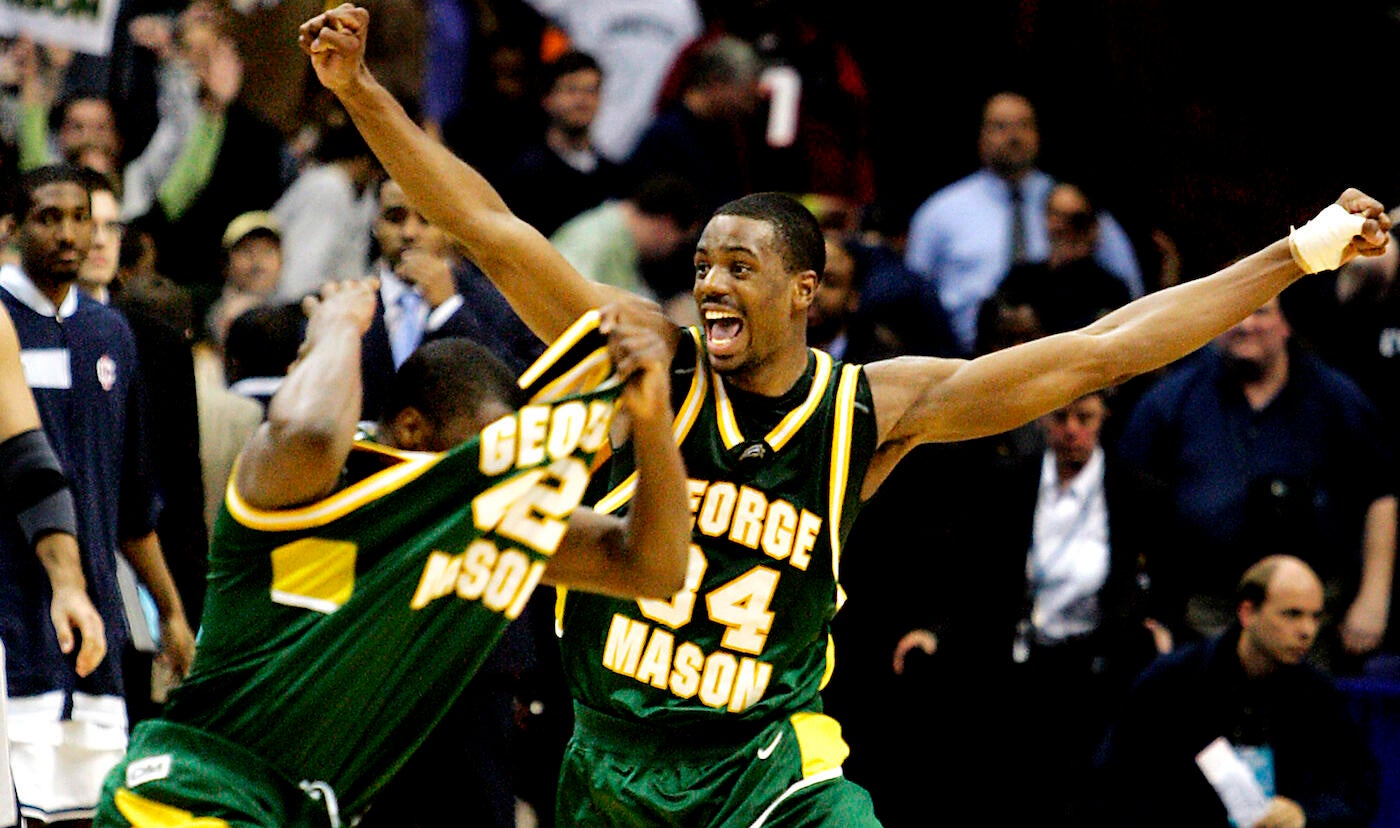
9. George Mason becomes the first mid-major make Final Four in modern era (March-April 2006).
You can make the case this is the top feel-good story on the list. Until George Mason came along, the idea of a mid-major breaking the dam in the modern NCAA Tournament to win four games and reach the biggest stage felt nearly impossible.
Then we all fell in love with a commuter school from Fairfax, Virginia, which knocked off some of the biggest programs (Michigan State, North Carolina, UConn) en route to an unforgettable Cinderella story. Tony Skinn, Jai Lewis, Folarin Campbell, Lamar Butler and Will Thomas set the template, with coach Jim Larranaga's easy-going disposition being the key ingredient to making his guys believe they could slay the giants.
The Patriots' 86-84 OT win over UConn remains one of the best games in NCAA Tournament history, the level of competition and thrill we hope every regional final can provide. GMU's run ended at the hands of eventual champions Florida, but all these years later, George Mason is remembered just as much for the 2006 tournament as the Gators' championship run.
If you want to go back and really understand what that run was about and some amazing details, I wrote a big feature on it in 2016.
8. UNC upsets Duke in Coach K's last game at Cameron Indoor Stadium and again at the Final Four (March, April 2022).
The peak point for the best rivalry in American sports.
Part 1: Duke's home finale, and the last time Mike Krzyzewski would ever coach at historic Cameron Indoor Stadium, ends with a stunner. Duke has the No. 1 offense, future No. 1 pick Paolo Banchero, is 26-4 going in and had defeated Carolina by 20 points a month prior.
What I wrote then: "This was to be Mike Krzyzewski's night. Duke staged one of the grandest send-offs college sports had ever seen. It was nostalgic. It was elaborate. It was quintessentially Duke. Which means a lot of people loved it and a lot of people hated it. Which means it was perfectly done. All of this created the biggest buildup, probably ever, to a regular-season college basketball game.
And then the greatest rivalry in American sports added to its legend with one of the more surprising upsets in its 102-year history.
Unranked, bubble-team-supreme North Carolina 94, No. 4 Duke 81. A Saturday night stunner at Cameron Indoor Stadium."
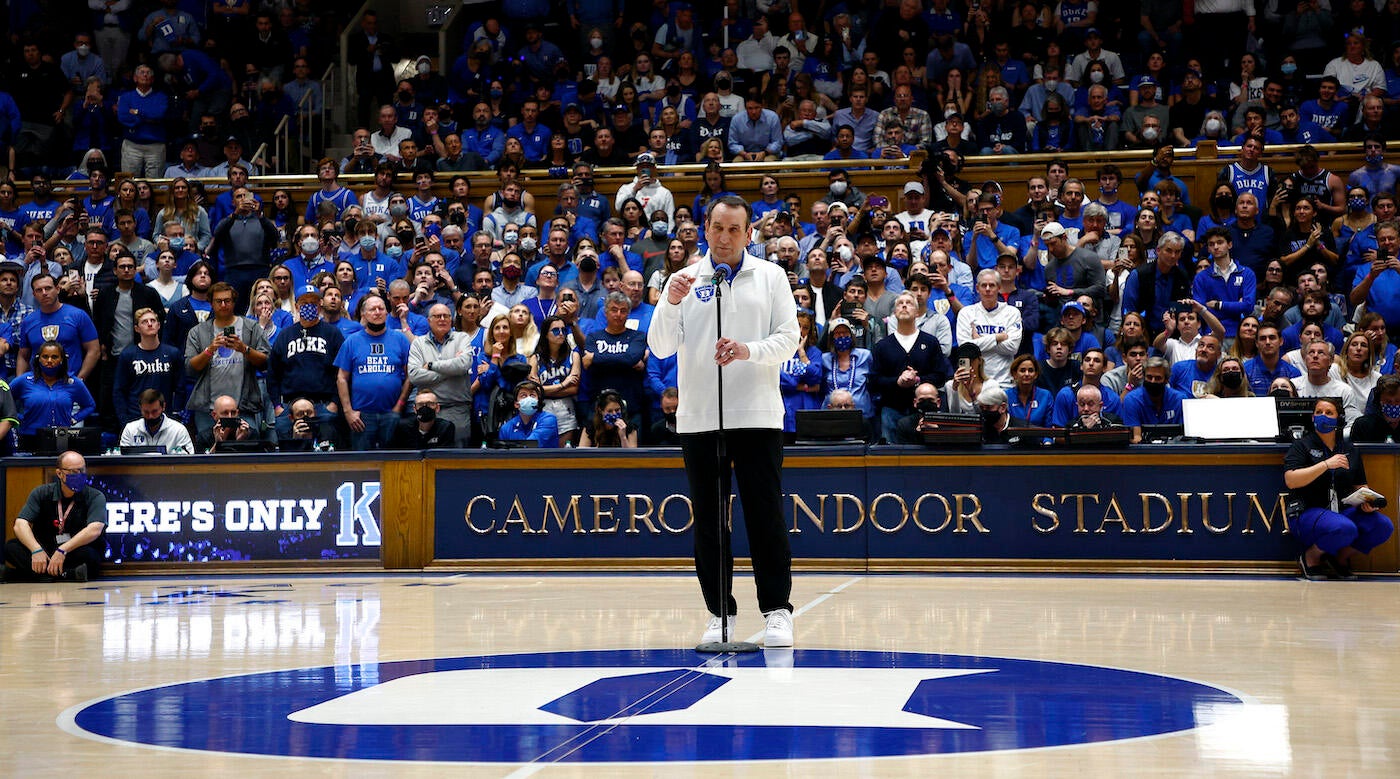
It was surreal to be in that hallowed building that night. And to think: Bigger drama awaited a month later.
In the Final Four, North Carolina and Duke played a bona fide classic, with eighth-seeded UNC holding on 81-77 over No. 1 Duke. The two programs had never met in the NCAA Tournament. For it to happen for the first time under these conditions felt cosmic. Images of Caleb Love's 3-pointer with 24.8 to go from the top of the key put UNC up 78-74 will be shown around Chapel Hill — and banned in Durham — in perpetuity.
What a gift it was as sports fans to see these two blue blood rivals face each other on that stage. No way Duke fans thought their team would lose again to Carolina. But that's sports.
7. Indiana fires Bob Knight (Sept. 12, 2000).
The oldest story on the list, but also obviously one of the biggest. Knight had an elongated denouement in Bloomington. After nearly 30 years on the job, including three national championships and 11 Big Ten titles, all of Knight's brilliance as a basketball mind couldn't out-scheme his bad behavior. His misdeeds caught up with him for good in 2000. In March of that year, CNN/Sports Illustrated aired a story that centered around former IU player Neil Reed, who claimed Knight choked him in a practice three years before.
Knight denied the story, only to find out footage of the incident existed — and CNN aired it soon after its initial exposé. At that point, many in the media (even beyond college basketball media) were weighing in on the saga, with no shortage of critics calling for Knight's termination. Because of his power in Bloomington, he held on to his job under a "no tolerance" stipulation.
A few months later, Knight was done. His aggressive behavior didn't entirely stop, the final incident ironically happening outside the parameters of his work with the basketball program. Knight allegedly grabbed the arm of an everyday student after he purportedly addressed the coach with a, "Hey, Knight, what's up?"
Twenty-nine years and canned at Indiana. Students on campus protested, with then-IU president Myles Brand was the center of the outrage. You can argue no coach had a stronger force of personality in the history of American sports than Knight. It brought him acclaim and criticism. To have his career at Indiana come undone by his own bellicosity was as predictable as it was sad.
6. The ultimate NCAA Tournament redemption story: UMBC upsets Virginia, Virginia wins the national title a year later (2018, 2019).
College basketball waited eons to see a 16-seed finally beat a No. 1. On March 16, 2018, the UMBC Terriers became immortal when they not only beat No. 1 overall seed Virginia, they blew their doors off, 74-54. Virginia looked and played like a team stricken by a voodoo curse in the second half.
Fortunately for the program, the one coach in the sport who was wired to handle such a humiliating loss was Tony Bennett.
And so, a year later, Virginia entered the tournament again as a No. 1 seed and reeled off one of the more thrilling title springs in NCAA history. In the Sweet 16, UVa beat Oregon 53-49, which put the Wahoos against Purdue in the Elite Eight. All that transpired was one of the five best games I've ever covered in person — an 80-75 OT win that was made possible after Mamadi Diakete took a pass from Kihei Clark right before time expired and sank the game-tying shot. Carsen Edwards went for 42, including 10 3-pointers, in one of the most heroic losing efforts in NCAA Tournament history.
Virginia escaped death vs. Auburn in the Final Four after Kyle Guy hit a corner 3-pointer with 6.5 seconds to go, and then a controversial foul call against Auburn gave UVa an escape hatch. In the title game against Texas Tech, the circle was made complete when De'Andre Hunter hit a corner trey with 12.5 to go to get Virginia to overtime. Then finished off the one-year script flip in OT.
This short capsule really doesn't do justice how unlikely Virginia's year-long journey was. As time goes on, its unique arc will become more appreciated.
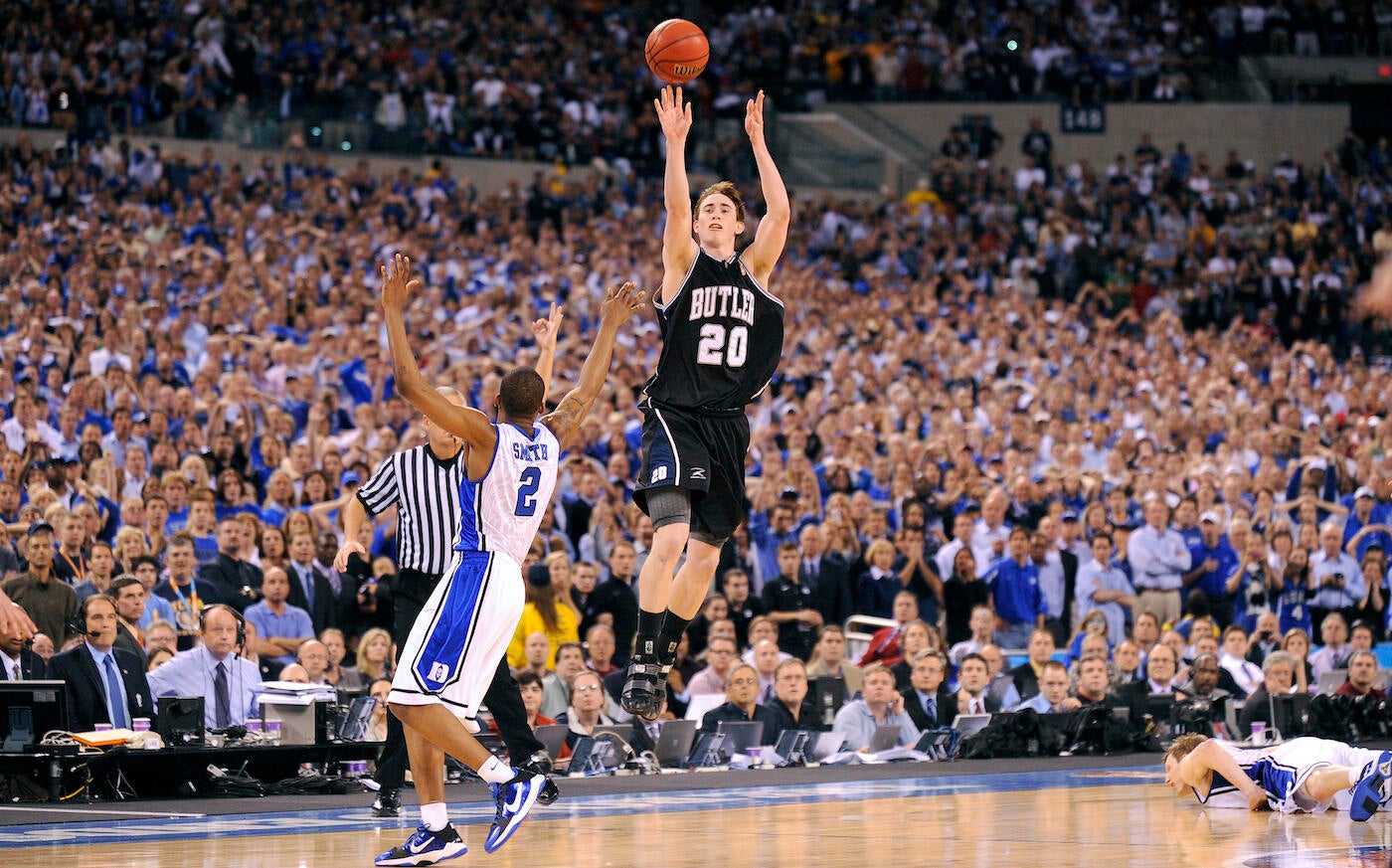
5. The Greatest Shot That Never Was: Gordon Hayward almost beats Duke and Butler makes back-to-back title games (2010, 2011).
How large must a moment be for a shot that didn't even go in to become one of the undying highlights in a sport's history? In a blink, Gordon Hayward's 45-foot prayer from a 30-degree angle that smacked off the glass and rolled off the rim after time expired on April 5, 2010 made millions blip into an alternate reality. Another universe where a mid-major from the Horizon League managed to win a national championship over the most popular blue blood in college basketball.
Instead, Duke won 61-59 in the first title game decided by a bucket in more than two decades. Seriously, go to about the three-minute mark of the second half and tap back into the tension of this title game. Butler had the game on its racquet.
Butler was a 33-win 5-seed heading into that title game, coached by then-33-year-old Brad Stevens, who was in his third season on the job. That was the best Butler team in history, with the No. 7 per-possession defense, a future top-10 in Hayward and program legends such as Shelvin Mack and Matt Howard playing alongside. Butler rode a 25-game winning streak into that Monday night. Duke was the No. 1 at KenPom that season, led by Kyle Singler, Jon Scheyer, Nolan Smith and Brian Zoubek.
The championship game run was made all the more special because it was staged in Indianapolis — just miles away from Butler's campus. It was the smallest school (enrollment all of 4,200 then) to make the Final Four in 30-plus years.
The next year, Butler was as a No. 8 seed and still made it all the way back to the final night. It escaped a wild first NCAA tourney weekend with grinders against Old Dominion and Pitt. In the Sweet 16, Stevens' team knocked off Wisconsin before edging Florida in OT in the Elite Eight. In 2011 it was Butler that was responsible for ending VCU's Final Four run, then got handled 53-41 by UConn (giving the Kemba storyline long-lasting power) in objectively the worst title game in modern history.
But for a mid-major to make back-to-back title games? That is astounding. I truly don't think we'll ever see it happen again, and that's why it ranks so highly here.
4. Murder, an attempted cover-up and the near-death of a program: The Baylor basketball scandal (June-August 2003).
The worst story on the list. A story so horrid, it involves murder and details so terrible they nearly ended a program.
With two gunshot wounds to the head, one Baylor player, Carlton Dotson, killed another, Patrick Dennehy, in June 2003. It took nearly two weeks for Dennehy's body to be discovered next to a rock quarry on the outskirts of Waco, Texas. Those details alone make this such a grim account, but it was worsened by then-Baylor coach Dave Bliss, who tried to save his job by scheming to portray the slain Dennehy as a drug dealer as a way for him to pay tuition. Dennehy "had no alcohol, opiates, amphetamines or barbiturates in his system" after undergoing an autopsy.
Bliss was motivated to shame a dead man's name because he paid for Dennehy's tuition, in addition to covering up positive drug tests with other players. So, Bliss tried to get his assistants and some of his players to lie to NCAA investigators. He was caught on tape when one of his newly hired assistants covertly recorded conversations between Bliss and the coaching staff.
"What we've got to do here is create drugs," Bliss said at the time, adding, "It's not like we created his situation. We're the victims."
Awful.
Making matters worse for the Dennehy family, Bliss reiterated his belief that Dennehy was a drug dealer when making the 2017 documentary "Disgraced." He confirmed that with our Dennis Dodd, who wrote a story on it at the time.
In 2003 it was all done to avoid NCAA detection. Instead, it led to Bliss' resignation and Baylor nearly got the death penalty for having its program associated with one of the worst scandals in college sports history. Dotson pleaded guilty to the murder in 2005 and was released from federal prison in the last year.
With all of this as context, it makes what Scott Drew did all the more incredible. He took the job in 2003 and oversaw one of the most unlikely rebuilds in American sports history, which culminated with the 2021 national title.
3. FBI investigation into fraud and bribery in college basketball makes national headlines and puts the sport on edge for nearly two years (2017-2019).
On Sept. 27, 2017, the FBI arrested 10 people connected to college basketball, including assistant coaches Tony Bland (USC), Chuck Person (Auburn), Book Richardson (Arizona) and Lamont Evans (Oklahoma State). Also arrested was Adidas exec James Gatto and an up-and-comer in the recruiting and agent space, Christian Dawkins.
It's been almost eight years since this story broke, but it's worth reminding people that when it came out, there was zero indication something like this was in the wind. And that was of course as intended. The FBI has something of a reputation of being covert, after all.
It was the rare story on this list that truly rocked the college basketball world — and beyond. A press conference was held that afternoon with a now-infamous flow-chart that laid out how the schemes were done and the infamous quote from Joon H. Kim to college basketball coaches across the country: "We have your playbook."
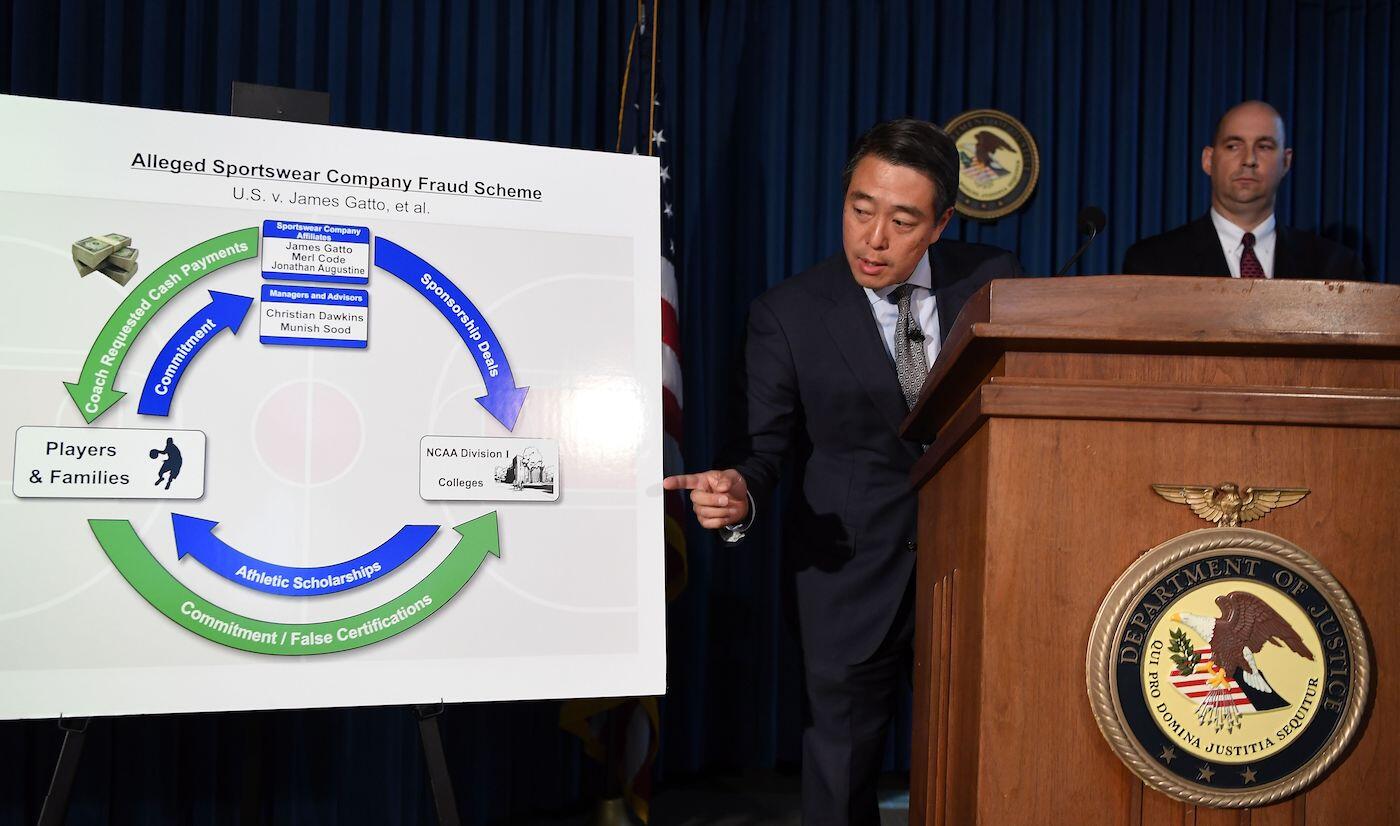
Except, they really didn't. Most coaches in the sport weren't caught up in the story or the schemes the FBI was selling, and in fact a lot of the activity that was caught is now legal in college sports. You can argue the whole thing was a massive waste of time and taxpayer money, but what's inarguable is how big this story was and how much fear it stoked into the sport.
It was thought that this story, when it broke in 2017, would lead to dozens of firings and the final exposure on all the pay-for-play cheating happening in college basketball. The ending didn't come close to delivering on the premise.
But there was still a lot of fallout, and I'd say that this case help usher in the player empowerment era. The biggest initial coaching casualty was Rick Pitino, whose career at Louisville could not survive another scandal. As a result, this investigation led to an unprecedented action: the NCAA stripping a basketball championship. Louisville no longer hangs its 2013 NCAA banner after that verdict was rendered on Feb. 20, 2018.
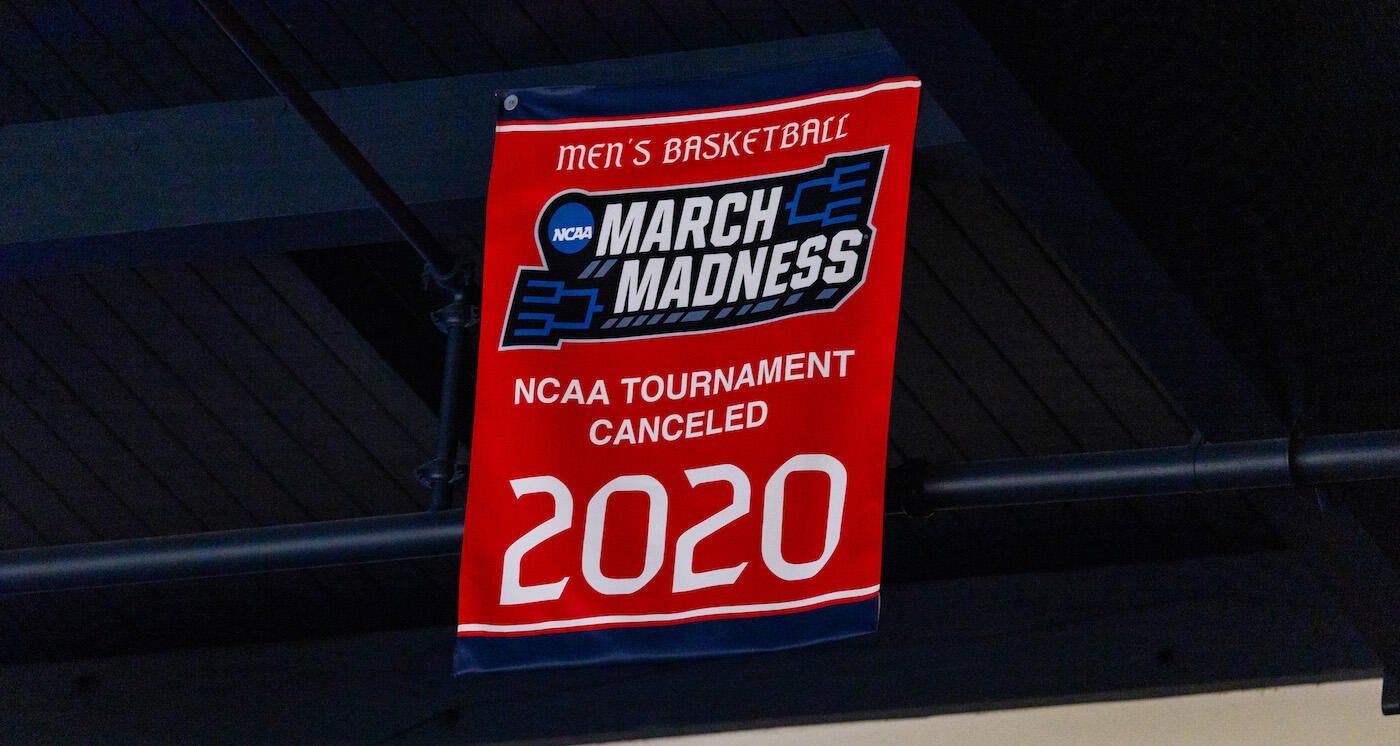
2. COVID cancels the 2020 NCAA Tournament (March 12, 2020).
When one of the biggest sporting events on the calendar is not held for the first time in its 80-plus-year history due to a global pandemic that puts the world in a vice grip, that's an all-time story.
Every American team sport, at some point, some way, found a path to stage a championship event in 2020 ... with the exception of college basketball. No March Madness for the first time since the tournament began in 1939. It's still a bother that 2020 has his void that will never be filled in, all because COVID-19 hit America soil with an increasingly aggressive wave just as the selection committee was meeting to build out the bracket.
The NBA's season was postponed the night of March 11, 2020, and that was the signal to the country that everything was about to change in a major way. It took less than 18 hours for the NCAA to make the call and do the inevitable. If you're interested to go back and read about what it was like, I wrote a tick-tock account just days after the tournament was killed.
Without a tournament to figure out a champion, fans of three schools in particular (that don't have NCAA titles) are left to wonder what could have been. Gonzaga (31-2), Dayton (29-2) and San Diego State (30-2) all had realistic hopes to be national champions that season. And it was all taken away. Fortunately, a bubble tournament was salvaged in 2021 before things were restored to normalcy in 2022.
1 Ed O'Bannon v. NCAA begins the inevitable: Transfer portal, NIL legislation and revenue-sharing ends century-old amateurism model (2009-present).
NCAA-affiliated lawsuits are so common these days, they're practically expected on a weekly basis. But in July 2009, the most important lawsuit in college athletics history was filed. Former UCLA All-American basketball player Ed O'Bannon sued the NCAA over an antitrust violation that stemmed from the NCAA and EA Sports using his likeness in a video game — and profiting — without his consent.
He was one of thousands.
It was morally indefensible, and the NCAA was finally going to pay for it.
The case took plenty of turns and stalls, ultimately requiring five years to move through the courts. O'Bannon eventually won in 2014. The NCAA appealed. More lawsuits came. The NCAA spent more than $100 million in legal costs and lobbying efforts over more than a decade's time to restrict the earning capacity of college athletes. What a waste.
In 2021, the NCAA's amateurism model was delivered another huge blow when the Supreme Court ruled unanimously in favor of the plaintiffs in the infamous Alston case. States passed laws that were player-friendly and protected them from action by the NCAA, empowering NIL legislation. That dovetailed with loosening of transfer rules, which prompted an era of transactional roster movement that sent college sports into chaos.
Has it all been for the better? No. But evolution is messy, and this is the most crucial period in NCAA history. Because for the first time, truly, players' rights matter. That set the stage for the House case, which led to the House case settlement, revenue sharing and where we are here, in July of 2025. The NCAA has been forced to change its philosophy, to bend on what it allows and what it stands for on a fundamental level. Because of it, there is no bigger story. O'Bannon v. NCAA started the slow death of amateurism and had a profound impact on all of college sports.
And still this story is not finished and in many ways won't be until college athletes can unionize and collectively bargain.
Whenever that day comes, it will be as big of a story as this one, as it's the last great frontier in college sports.


